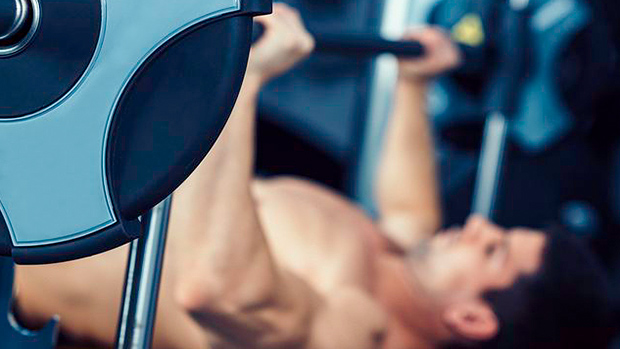If you want to look better with your shirt off or perform better athletically, there are two things you should be striving for: improved recovery and better muscle performance. This is a no-brainer and a primary reason for the huge success of steroids over the decades (steroids improve both recovery and performance). I've yet to meet one individual who thought his recovery was too rapid or his muscle mass was too great. So what sets two weight-training individuals with sub-par genetics apart from each other in terms of progression? Answer: recovery.
But what is recovery really and how is it facilitated? There are many complex aspects of recovery, but one of the most important is nutrient transfer. We all know that weight training increases blood flow to the muscles being worked. But do we ever really think about what that means or how to maximize it to help us reach our goals? Probably not, but that's what this article is for!
Alright, time for some very basic physiology. In regard to blood flow, the body has a network of extremely small blood vessels called capillaries. Their primary function deals with the exchange of oxygen, hormones, amino acids, glucose and lipids among other things. The exchange of certain nutrients at the capillary level is sometimes referred to as nutrient transfer. This blood flow through the capillaries remains relatively constant under resting conditions, but as soon as a muscle starts contracting, the blood flow is increased. It's with these extremely small capillaries that the muscles are supplied with all the nutrients they need for recovery. Pretty simple, huh?
Your capillary-to-muscle-fiber ratio is expressed as the term capillary density. Obviously, the more capillaries you have within the muscular system, the better the nutrient transfer. Unfortunately, increased fiber area (hypertrophy) through heavy resistance training leads to a decrease in capillary density (1). This could be one of the reasons why weightlifters with a large amount of muscle mass take longer to recover than their less massive peers.
Based on the above information, it's pretty clear increased blood flow within the muscle will increase nutrient transfer, thus aiding recovery. We also learned that heavy resistance training decreases capillary density by increasing the fiber area without a subsequent increase in capillaries. So, you're probably wondering if there's a way to increase capillary density? You bet there is. It's called endurance training!
In volume three of The Encyclopaedia of Sports Medicine: Strength and Power in Sport, world-renowned physiology researcher P.A. Tesch makes the following statement: "Numerous studies have demonstrated that the capillary supply, either expressed as capillaries per fiber or as capillaries per mm(squared), increases in response to endurance training." (2)
I know, I know, endurance training sounds about as pleasant to an avid iron-thrower as a 100-gram dose of soy protein. But it's a well-known fact that endurance training increases capillary density. Don't you worry though, 'cause this ain't no wussified version of endurance training! This method will help you improve recovery, gain muscular endurance and increase hypertrophy. If that sounds good to you, read on.
Since I'm a strength and conditioning coach, I'm constantly faced with dilemmas involving performance improvement. Since I own my training company, I can pretty much experiment with whatever I want, whenever I want. Therefore, I've tried many crazy schemes over the years in attempt to help solve some of the problems we all face as weight trainers. Some have worked, most have not. But I'm going to share with you one of my best discoveries so far: The 100 rep-a-day program.
Here's how it works. First, decide which body part you feel is lagging the most (if you answer "all of them!" we have a problem). Hopefully, the incredible amount of information T-mag has provided over the years has given you a good jump on your physical goals and aspirations. Let's say you pick calves and biceps. Yes, you can pick two muscle groups if they're small. For instance, if you feel your calves and biceps are lacking, then you're allowed to use the 100 rep-a-day program for both muscles simultaneously. If you choose a large muscle group like the chest or hamstrings, then use the program for those body parts independently. Here's a list for the sake of clarity:
Small body parts (pick two if you want)
- Biceps
- Triceps
- Calves
- Forearms
- Delts
- Abdominals
Large body parts (pick one only)
- Quadriceps
- Hamstrings
- Pectorals
- Lats
- Glutes/Lower Back
Now that you've chosen the muscle group(s) you want to improve, pick a single exercise for the targeted muscle group(s). Obviously, the list is endless but I'd strongly recommend an exercise that requires very little equipment, if possible. Here are a few exercises I like to use but feel free to use whatever you want:
- Calves
- Standing Calf Raises (1 or 2 legged)
- Donkey Calf Raises
- Quadriceps
- Bodyweight Full Squats
- Bodyweight Low Box Squats
- Hamstrings
- Standing Leg Curl (with ankle weight)
- Lying Leg Curl (with ankle weight)
- Low Back/Glutes
- Reverse Hypers
- Abdominals
- Sit-ups (with feet hooked)
- Leg Raises
- Chest
- Dumbbell Bench Press (flat or inclined)
- Push-ups
- Lats
- Straight Arm Pulldowns
- Pullovers
- Biceps
- Standing Dumbbell Curls (hammer grip or supinated)
- Incline Dumbbell Curls (hammer grip or supinated)
- Triceps
- Pressdowns (cable or band)
- Lying Dumbbell Extensions
- Delts
- Standing Dumbbell Side Raises
- Bent Over Dumbbell Side Raises
- Forearms
- Plate Wrist Flexion *
- Plate Wrist Extension * *
* Place a small plate in your hand with your fingers on one side and thumb on the other. With the palm supinated (facing up), flex your wrist.
* * Same as above except the palm is pronated (facing down) and the wrist extends back.
I don't want you to worry about finding a certain percentage of your one rep max (1RM). If you do want to find it for the given exercise, I'd recommend 20% of that value, but I'm not requiring you to do so. As long as the load doesn't induce excess fatigue and as long as you stop well short of failure on every set, you'll benefit.
Now that we know the muscle groups and exercises, let's get to the rest of the details. I want you to perform 100 reps each day for the chosen exercise(s). (This is in addition to your regular workout, but I'll talk about that a little more later.) There are countless ways to do the 100 reps (I've tried them all), but I can honestly say there's no dramatic difference between any of them as long as you avoid muscular failure. In other words, don't do 100 reps continuously for one set each morning because the induced fatigue will halt your progress on your higher intensity weight-training workouts. Instead, avoid muscular failure like HIT trainees avoid German Volume Training! This is the most important point; you must never come close to muscular failure on any set.
Here are some rep breakdowns I found to be effective:
Method 1
- Morning: 50 reps
- Evening (about 12 hours later): 50 reps
Method 2
- 25 reps every fourth hour until you reach 100
Method 3
- 10 reps every hour until you reach 100
Let's say you want to use the 100 rep-a-day program for your biceps and calves. You have a desk job and can only do exercises in the morning and at night so you pick the first method. The two exercises you chose are standing dumbbell hammer curls and standing calf raises. Like most trainees, you don't want to take the time to find your 1RM so you grab some light dumbbells that you could curl 50 to 60 times before failure. You decide to just use your bodyweight for the calf raises off a step in your house. That plan looks good to me. Here's the breakdown:
Morning
- Exercise: Standing Dumbbell Hammer Curls and Standing Two Leg Calf Raises
- Sets: 1 set of each
- Reps: 50 of each
- Tempo: 2010 (two seconds up, no pause, one second down, no pause)
Evening (12 hours later)
- Exercise: Standing Dumbbell Hammer Curls and Standing Two Leg Calf Raises
- Sets: 1 set of each
- Reps: 50 of each
- Tempo: 2010
- Frequency: Every day that's not part of your normal bicep/calf workout routine for eight weeks (or until necessary).
You should notice I prescribe a tempo that doesn't emphasize the eccentric (negative) phase. Don't discredit this very important point. I don't want the negative phase of the movement emphasized in any way. If it is, you could easily overtrain the muscles and induce muscle soreness, something we want to avoid.
You should perform this routine on a daily basis without decreasing the bicep and calf work during the higher intensity weight-training program you're already on. Perform the 100 reps on every day you don't do your normal calf and bicep work. For instance, if you normally perform your biceps/calf work on Monday and Thursday, do this program on the other five days of the week. Remember, these are extra endurance workouts and should not take the place of the resistance training program you perform each week in the gym.
- Never work to failure on any of the 100 rep exercises.
- If your performance is suffering on higher intensity days, reduce load of 100 rep scheme (in other words, use less weight).
- Try to break up the 100 reps as much as possible throughout the day.
- Use bodyweight exercises as much as possible and avoid machines.
Now, with all this talk of nutrient transfer and recovery, I must make a very important point. Without proper nutrition, nothing works extremely well. Simply put, you need a steady supply of nutrients for nutrient transfer to take place! Therefore, get well acquainted with T-mag's articles on protein consumption and proper nutrition.
As with any program, individual results will vary, but you should expect improved recovery of your regular weight training workouts (due to increased capillary density and nutrient transfer), greater muscular endurance and increased muscle mass due to sarcoplasmic hypertrophy (i.e. growth of the interstitial fluid area).
Mr. America (1966), Bob Gajda, used a similar method to put a full inch on his lagging calves in only eight weeks. Due to my extremely poor calf recovery rates, I started performing 100 standing calf raises each day. After a few weeks, my improved recovery rate allowed me to perform high-intensity calf work every third day instead of every fifth. You can't beat that!
If, for whatever reason, the 100 rep-a-day plan doesn't induce hypertrophy for you, the newfound recovery rates and muscular endurance will allow you to perform your high intensity sessions more frequently. Remember, more workouts mean more progress!
- Tesch, P.A., et al. (1984) Muscle capillary supply and fiber type characteristics in weight and power lifters. Journal of Applied Physiology, 56, 35-8.
- Short- and Long-Term Histochemical and Biochemical Adaptations in Muscle. (1992). In The Encyclopaedia of Sports Medicine (Vol. 3, p. 242). Cambridge: Blackwell Science.





